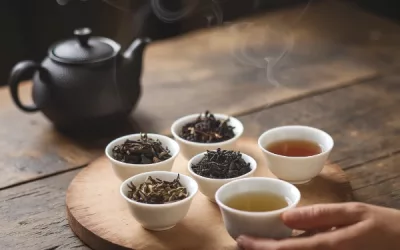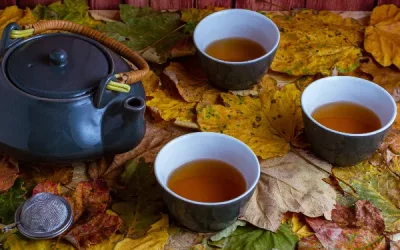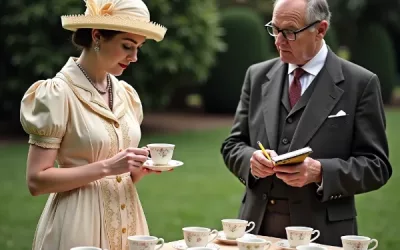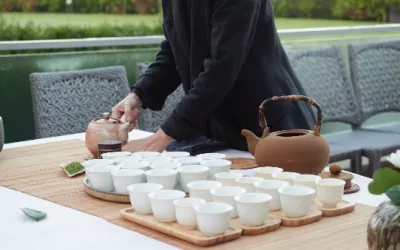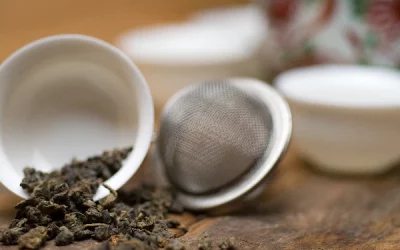Did you know that the way you store loose leaf tea can significantly impact its flavour and aroma? For tea enthusiasts, understanding the nuances of proper storage is crucial not just for enjoyment, but also for health benefits. In this guide, we’ll explore essential factors affecting tea quality, including air exposure and temperature, as well as the best containers and common pitfalls to avoid. Our main aim is to equip you with the knowledge to keep your loose leaf tea fresh and delightful long after you’ve purchased it.
Table of Content
- What factors affect the quality of stored loose leaf tea?
- What Are The Best Containers For Storing Loose Leaf Tea?
- How long can loose leaf tea be stored before it loses quality?
- Can I freeze loose leaf tea for long-term storage?
- How should herbal teas be stored differently from traditional teas?
- What common mistakes should I avoid when storing loose leaf tea?
- What are the signs that my loose leaf tea has gone stale?
- How can I maximise the freshness of my loose leaf tea?
- Conclusion
What factors affect the quality of stored loose leaf tea?
Storing loose leaf tea properly ensures that you can savour its full flavour and aroma. Several factors can significantly affect the quality of tea over time. Understanding these can help you maintain your tea’s quality, whether you’re a casual drinker or a passionate connoisseur.
Air exposure, moisture control, light protection, temperature regulation, and time sensitivity all play crucial roles in maintaining tea quality. Each of these elements can either preserve or degrade the flavour, aroma, and freshness of your tea.
How does air exposure impact tea freshness?
Air exposure can quickly lead to oxidisation, which deteriorates both flavour and scent. The more a tea is exposed to air, the more it loses its essential oils and aroma. Here’s how you can minimise air exposure:
- Store tea in airtight containers.
- Use containers that are filled to the brim to reduce air space.
- Consider vacuum-sealed bags for longer storage.
- Avoid frequently opening the container.
Preventing air exposure will keep your loose leaf tea fresh and flavourful, allowing you to enjoy each cup as intended.
Why is moisture control crucial for tea storage?
Moisture is one of the most damaging factors when it comes to storing loose leaf tea. Excess moisture can lead to mould growth and spoilage, ruining your tea supply. Here are a few ways to control moisture:
- Use silica gel packets in your tea storage containers.
- Keep tea away from humid areas like the kitchen or bathroom.
- Store tea in a cool, dry place.
- Use moisture-resistant containers.
By controlling moisture, you can prevent mould and maintain the tea’s original flavour.
What role does light play in tea quality?
Light, particularly UV light, can degrade the quality of loose leaf tea by breaking down its chemical structure. This degrades the flavour and aroma. To protect your tea from light damage:
- Store tea in opaque containers.
- Keep tea in a dark cupboard or pantry.
- Avoid storing tea in transparent jars unless they are kept in a dark place.
- Use containers with UV protection if you prefer glass jars.
Shielding your tea from light keeps its natural characteristics intact, ensuring a delightful experience every time you brew a cup.
In the 18th century, Catherine of Braganza, the queen consort of England, popularised tea drinking among the English nobility. Initially, tea was an exotic luxury and was stored with great care to preserve its quality.
Tea caddies with intricate locks and keys were often used to prevent servants from pilfering the precious leaves. These early storage methods underline the importance of protecting tea from air, moisture, and light, much like we do today.
I remember when I first started drinking loose leaf tea. I used to store it in a clear glass jar on the kitchen counter because it looked pretty. However, I soon noticed my tea lost its flavour quickly.
After some research, I realised how crucial proper storage is. I switched to opaque, airtight containers and kept them in a cool, dark pantry. The difference was remarkable – my tea stayed fresh and aromatic for much longer. Now, every cup is as good as the first.
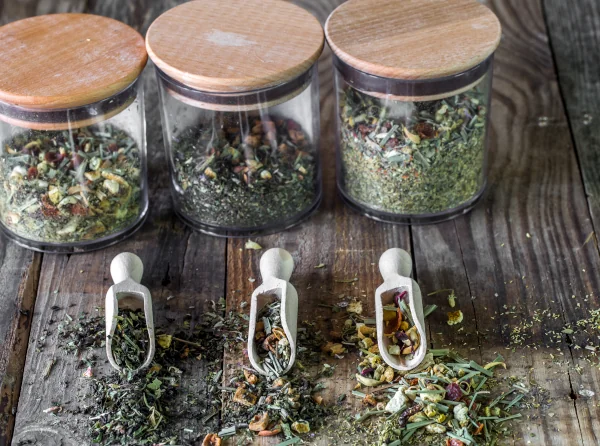
What Are The Best Containers For Storing Loose Leaf Tea?
Storing loose leaf tea properly is essential to preserving its flavour, aroma, and freshness. The right container can make a world of difference. Let’s dive into the different types of containers, their benefits, and their recommended uses to help you decide the best one for your needs.
To use the table below, simply match the type of container with its benefits and recommended use. This will guide you in selecting the ideal storage solution for your loose leaf tea.
| Container Type | Benefits | Recommended Use |
|---|---|---|
| Tin Canisters | Airtight, blocks light | Everyday storage, short to medium term |
| Ceramic Jars | Neutral material, preserves flavour | Long-term storage, special teas |
| Glass Jars | Airtight, visually appealing | Display storage, frequent use |
| Plastic Containers | Lightweight, inexpensive | Temporary storage, travel |
| Mylar Bags | Excellent oxygen barrier, lightweight | Long-term storage, bulk purchases |
| Stainless Steel Canisters | Durable, light-blocking | Daily use, on-the-go |
| Wooden Boxes | Aesthetic appeal, moderate air barrier | Decorative storage, gifting |
| Vacuum-Sealed Bags | Maximum freshness, compact | Long-term storage, rare teas |
Each of these containers offers unique advantages depending on how you plan to store and use your loose leaf tea. Let’s explore some more details about using these options effectively.
How to store loose leaf tea in tin canisters
Tin canisters are a popular choice due to their ability to keep air and light out. These factors can degrade tea quality over time. Here’s why tin canisters work well and how you can use them effectively:
- Airtight Seals: Tin canisters often come with tightly fitting lids, which prevent air from entering and affecting the tea leaves.
- Light-Blocking: Tins block light, which helps preserve the delicate flavours and aromas.
- Durability: They are sturdy and can withstand being stored in a variety of places.
To make the best use of tin canisters:
- Ensure the lid fits snugly to prevent air ingress.
- Store the canister in a cool, dry place away from direct sunlight.
- Label each canister with the type of tea and the date of storage for easy identification.
Why ceramic jars are ideal for long-term storage
Ceramic jars are excellent for long-term storage. Their neutral material doesn’t affect the tea’s flavour, making them ideal for high-quality and special teas. Here’s a closer look at their attributes:
- Neutral Material: Ceramic doesn’t react with the tea, preserving its natural taste.
- Airtight Options: Many ceramic jars come with rubber seals that make them airtight.
- Aesthetic Value: Ceramic jars can be quite beautiful, adding a decorative touch.
To store your tea in ceramic jars:
- Choose jars with airtight seals to keep air and moisture out.
- Store in a cool, dark place to maintain optimal freshness.
- Consider using ceramic jars for special teas you don’t consume daily, preserving them for longer enjoyment.
Centuries ago, during the Tang Dynasty in China, tea storage was taken very seriously. People used specially crafted ceramic jars to keep tea leaves fresh. These jars were glazed on the inside to prevent any interaction with the tea.
Traders would travel long distances with these precious ceramics, ensuring that the tea reached its destination in perfect condition. This practice highlights the importance of proper storage in maintaining tea quality—a principle that still holds today.
I remember when I first got into loose leaf tea, I stored my tea in simple plastic bags. The flavours quickly faded, and I was left disappointed. It wasn’t until I invested in a few good tin canisters and a beautiful ceramic jar that I truly appreciated the difference.
The tea stayed fresh for much longer, and every cup felt like a small luxury. Now, I enjoy experimenting with different containers and sharing tips with fellow tea enthusiasts.
How long can loose leaf tea be stored before it loses quality?
Alright, so you’ve got your hands on some fancy loose leaf tea. You know, the good stuff—not that dusty stuff in bags. But now you’re wondering, “How long is this going to stay good for?” Let’s get down to brass tacks.
Loose leaf tea actually comes with a pretty decent shelf life, considering it’s essentially dried leaves. But like any other consumable, it’s not immortal. Generally, loose leaf tea can comfortably last you anywhere from six months to a year for your green and white teas.
If you’ve got black or oolong tea, you can stretch that timeframe to two years. And keep your puerh tea dancing in your cupboard for decades if stored properly.
But hey, not all teas are created equal, and the freshness clock starts ticking the moment it’s processed. So, how do you keep it fresh and worthy of your cup? Let’s dive into that.
What is the average shelf life of loose leaf tea?
- Green tea: 6 months to 1 year
- White tea: Up to 1 year
- Black tea: 1 to 2 years
- Oolong tea: 1 to 2 years
- Puerh tea: Decades (Yep, you read that right)
The more oxidised the tea, the longer it’s likely to last. Less moisture means less chance of your tea going the way of an overripe banana.
How can I tell if my tea is still fresh?
Alright, Sherlock, time to use those detective skills. Here’s how to know if your tea is still in its prime or ready for the bin:
- Smell: Does it still have that robust aroma? If it smells like old paper, it’s a goner.
- Colour: Dull or faded leaves mean the tea’s taken a one-way ticket to Blandsville.
- Texture: Crisp and dry leaves are the hallmark of freshness. If they’re limp or moist, you’re in trouble.
- Taste: If it tastes like you’re drinking tepid water, the game’s over.
What storage conditions can extend the life of tea?
Listen, this isn’t rocket science, but there are a few things to keep in mind. Proper storage can make the difference between an exquisite brew and a sad excuse for a cup of tea.
- Cool and dry environment: Avoid heat and moisture like the plague. Cupboards away from stoves and humid spots are your best bet.
- Airtight containers: Oxygen is not your tea’s friend. The less air, the better. Vacuum-sealed jars or tins work wonders.
- No light: Sunlight is great for plants, terrible for tea. Keep your stash away from those UV rays.
- Don’t mingle: Tea is like a sponge for odours. Keep it away from strong-smelling substances like garlic or spices.
- No fridge, no freezer: Sure, this sounds counterintuitive because cold means preservation, right? Nope. Condensation will spoil your tea quicker than you can say “Oh no!”
Remember Lu Yu, the Sage of Tea, who wrote “The Classic of Tea” in the Tang Dynasty made meticulous notes on proper storage. Though he didn’t have vacuum-sealed jars, he was all about those cool, dry, and dark conditions. Means something, right?
So there you have it. Keep your tea happy, and it’ll keep you happy. Happy sipping!
Can I freeze loose leaf tea for long-term storage?
Picture this: you’ve just scored a stash of fancy loose leaf tea that could fuel a small village of enthusiasts. Naturally, you think, “How can I make this last without sacrificing those divine flavours?” The debate rages on, but let’s dive straight into the pros and cons of freezing loose leaf tea.
Firstly, freezing tea is like playing a delicate game of Jenga: one wrong move, and the whole structure collapses. While freezing can indeed extend your tea’s shelf life and lock in flavour, it comes with a set of strict instructions and potential pitfalls. Below, we break it down for you.
What are the benefits of freezing tea?
Freezing tea, if done right, offers some serious perks:
- Extended Shelf Life: Freezing can prolong the freshness of your loose leaf tea significantly.
- Flavour Preservation: Properly frozen tea keeps its essential oils intact, preserving the tea’s original flavours and aromas.
- Reduced Oxidation: By freezing, you slow down oxidation, allowing your tea to maintain a more consistent flavour profile.
- Bulk Storage: Got a large quantity of tea? Freezing helps you store it without worrying about it going stale.
On the flip side, the art of freezing tea is fraught with nuance. It’s not simply chucking it into the freezer.
Are there any risks associated with freezing tea?
Of course, every rose has its thorns:
- Moisture Risk: Frost can form if not sealed properly, leading to soggy, flavourless tea. Blergh!
- Odour Absorption: Tea loves to soak up odours. If not tightly sealed, welcome to garlic-flavoured Oolong.
- Texture Changes: For some delicate teas, freezing could alter the texture, affecting the steeping experience.
- Energy Use: Keeping your freezer running just for tea might not be eco-friendly. Food for thought!
To mitigate these risks, you’d need to follow certain guidelines to a T… or in this case, to a ‘tea’.
How should I prepare tea for freezing?
You’ve committed to freezing, and you want to ensure you do it correctly. Here’s your step-by-step guide:
- Use Airtight Containers: Mason jars, vacuum-sealed bags, or airtight tins—pick your poison for optimal protection.
- Divide into Portions: Only freeze the amount you plan to use in one go. Constantly opening and closing can lead to moisture build-up.
- Label and Date: Sounds basic? But you’ll thank yourself later when you know exactly when it was frozen. Freshness is key!
- Freeze Quickly: Ensure your tea is at room temperature before popping it into a pre-cooled freezer. Rapid freezing helps maintain integrity.
- Avoid Frequent Thawing: Thaw in small batches to prevent repeated freeze-thaw cycles, which can mess with your tea’s delicate balance.
With these methods, you’re well on your way to freezing success. However, keep in mind that not all teas are born equal in this scenario.
What types of tea are suitable for freezing?
While most teas play along, some are clear winners in the freezing department:
- Green Tea: Its freshness benefits greatly from freezing, maintaining those grassy notes.
- White Tea: Delicate and prone to rapid decline without freezing; freezing saves the day here.
- Oolong Tea: Especially high-quality ones, preserve both flavour and aroma well.
- Black Tea: Tends to handle freezing without much hassle.
While doable, think twice before freezing:
- Herbal Teas: Depending on ingredients, some can turn funky in the freezer.
- Flavoured Teas: Oils and flavours added to these teas may not chill out as well as expected.
Freezing is an art and demands a bit of finesse, but done right, it allows you to savour your stash for much longer periods.
Back in ancient China, renowned as the birthplace of tea culture, traders during the Ming Dynasty devised creative methods to protect their precious tea cargo while traveling vast, diverse terrains.
They implemented natural refrigeration techniques in mountainous regions, wrapping the tea in bamboo leaves and sealing it in clay urns. Although not the same as modern freezing, these early efforts highlight humanity’s age-old determination to preserve the integrity of tea, underscoring that our contemporary strategies aren’t entirely without historical basis.
How should herbal teas be stored differently from traditional teas?
When it comes to ensuring your tea remains as fresh and flavourful as possible, storage is key. But let’s be real: herbal teas can be a bit high-maintenance compared to their traditional counterparts. We’re talking moisture sensitivity, light exposure, and container recommendations. Buckle up!
Right off the bat, herbal teas are essentially dried herbs, fruits, and flowers. Unlike traditional teas that come from the Camellia sinensis plant, herbal teas can be moodier and more perishable. We’ve got to treat them differently if we want to avoid sipping on something that tastes like an old attic.
What unique challenges do herbal teas present?
Herbal teas have unique considerations because they come with their own set of quirks and whims.
- Moisture Sensitivity: Herbal teas absorb moisture like there’s no tomorrow. Trust me, the tiniest bit of dampness can turn your flower petals and lemon verbena into a soggy mess.
- Light Exposure: Sunshine might be great for tanning, but it’s a sworn enemy of herbal teas. UV light can degrade their delicate flavours and health benefits faster than you can say ‘sun damage.’
- Aroma Absorption: These teas are like sponge for scents. If you store them near your garlic stash, guess what? Garlic-flavoured tea.
- Varied Shelf Life: Different herbs have different shelf lives. Some might lose potency quicker than others.
- Consistency Variability: The assorted nature of herbal teas can mean inconsistent drying and storage requirements.
So, while traditional teas are usually more robust and less volatile, herbal teas require a lot more TLC.
How can I effectively store herbal teas?
Alright, enough with the doom and gloom. Let’s get you geared up to store those herbal concoctions like a pro.
- Airtight Containers: Invest in some high-quality, airtight containers. Keep that moisture out!
- Opaque Tins or Jars: Keep the light away by using opaque storage solutions. Clear glass jars? Big no-no.
- Cool, Dry Place: Store your tea in a cool, dry spot. Your kitchen cupboard is usually a safe bet.
- Separate Storage: Store each type of herbal tea in its own container to avoid flavour contamination.
- Regular Checks: Periodically check your stock for any signs of moisture or degradation.
Keep these points in mind, and you’ll never have to endure lacklustre herbal tea again.
Are there any special considerations for herbal tea storage?
Absolutely! These teas don’t just have run-of-the-mill requirements. They need some special love to maintain their quality.
- Short-Term vs. Long-Term Storage: If you’re storing for a long time, consider vacuum-sealed packs to lock in freshness.
- Temperature Fluctuations: Avoid storing them in places that experience significant temperature changes, like above the stove or near a window.
- Avoid Plastic: Plastic can impart unwanted flavours and doesn’t provide the best airtight seal.
- Use Labels: Label your containers with purchase dates. You’d be surprised how easy it is to lose track.
- No Refrigeration: Resist the urge to store in the fridge. The fluctuating humidity levels can wreak havoc.
These little tweaks can make a big difference in how enjoyable your cup of herbal tea will be.
Talking about storage, let’s dip into a nugget of tea history. Back in the 1700s, tea was so precious in Great Britain that tea leaves were often stored in ornate, lockable tea caddies. Families would use tiny keys to unlock these mini vaults. Anna, the Duchess of Bedford, supposedly popularised the practice of afternoon tea.
To ensure the freshest leaves were on her table, she had a trusted servant who’d guard the tea caddy like it was gold. Who would’ve thought our beloved tea once needed its own security detail? The next time you store your herbal tea, think about those old-timey Brits treating their leaves like treasure—you’re in good company!
What common mistakes should I avoid when storing loose leaf tea?
Alright, friend, let’s get down to business. You’re a tea enthusiast, right? Maybe a touch of a hobbyist too? Great. You’ll want to treat your loose leaf tea like fine wine, with a sprinkle of health-conscious magic. So, sit tight because we’re going to tackle the common blunders in tea storage.
You’d be surprised how many folks leave their precious leaves to suffer under suboptimal conditions. Let’s make sure you’re not one of them.
First up, the enemies of loose leaf tea: air, humidity, and light exposure. Storing tea in non-airtight containers is about as effective as wearing flip-flops in a snowstorm. Then, there’s humidity – anathema to tea!
You might think your tea jar looks chic on the kitchen counter, but light supports oxidation like nobody’s business. Firmly avoiding these mistakes can be the difference between a delightful brew and something that resembles dishwater. Ready to dive in?
What are the most common mistakes in tea storage?
So you’re excited about storing your precious loose leaf tea. But wait! Here’s what you need to steer clear of:
- Non-airtight containers: Seriously, nothing says “I don’t care about freshness” more.
- High humidity zones: Think about it – tea loves dryness. Storing it in Aunt Mabel’s steamy kitchen? Disaster.
- Light exposure: Your tea isn’t a sunbather. It loathes light.
- Not sealing the package properly: If you’re making a half-hearted job of closing the lid, you might as well chuck the tea down the drain.
- Using smelly storage containers: Ever had that whiff of last night’s garlic pasta? Now imagine your tea soaking it up. Not pleasant!
Air, moisture, and light are absolute deal-breakers. The moment tea meets these elements, its freshness and flavours begin to nosedive. Keeping it in a sadly loosely-sealed plastic bag, you’re asking the tea gods to curse your mornings.
How can I prevent these mistakes?
Congratulations, you’re keen to store your tea correctly. Let’s run through some simple yet spot-on ways to keep your tea in tip-top shape:
- Invest in good airtight containers: Tin or ceramic work best. Leave the plastic for tupperware parties.
- Store your tea in a cool, dry place: No, your bathroom cupboard is not a viable option.
- Rotate your tea stock: First in, first out. No need to play Indiana Jones with your tea collection.
- Keep it in the dark: Your tea yearns for a darkened corner, kind of like a tea vampire.
- Label your containers: Make sure you can distinguish between that delightful Earl Grey and chamomile.
Equip yourself with containers that scoff in the face of air infiltration. Use canisters with a robust seal. Now, put those somewhere snug and free from the tyrannous rule of humidity. A cool pantry or cupboard works wonders. And please, those glass jars that look oh-so-fancy on Instagram?
Just for the photoshoot. Then, it’s back to the dark cupboard!
What are the consequences of improper storage?
Oh boy, improper storage isn’t just annoying; it can devastate your tea game. Here’s what’s in store if you don’t heed these warnings:
- Loss of flavour: Tastes like cardboard. Or worse – nothing.
- Increased mould risk: Think furry stuff. Eek!
- Oxidation: Your tea’s personality; it dwindles faster than a summer romance.
- Infusion of odours: Imagine your tea savouring your curry from last night. Ew.
- Stale tea: Ever chewed on sawdust? Now you know.
Bitterness and disappointment plumbing to new depths each time you sip. Properly stored tea maintains the robust flavours and nuanced aromas that make your heart sing. Without care, you might as well be brewing hay.
Without an airtight container, humidity works overtime, and light, oh light, the sneaky despoiler, wreaks havoc on antioxidants.
Back in the 17th century, when tea was a prized import, wealthy European aristocrats stored their tea in ornate, locked tea caddies to keep it under wraps from servants, light, and air.
Lady Mary Wortley Montagu even had her own way to store loose leaf tea to safeguard its freshness and maintain its valuable flavours. You, my friend, are just a modern-day connoisseur continuing a centuries-old tradition.
So, treat your tea as it deserves, and it will reward you sip after delicious sip.
What are the signs that my loose leaf tea has gone stale?
Right, you’ve got your fancy loose leaf tea. You made the mistake of treating it like that bizarre Christmas fruitcake stuffed in the back of your pantry. Tea is delicate and doesn’t last forever. It’s time we tackle the elephant in the room – stale tea.
There’s a certain artistry to fresh loose leaf tea. It greets you with a delightful aroma, a flavour punch, and a visual display that’s rather pleasing. Stale tea, however, couldn’t be more different. Here’s how to tell if it’s past its prime:
How can I tell if my tea has lost its flavour?
Ever had a cup of tea that tastes like cardboard mixed with regret? That’s the taste of stale tea.
- Dullness: Fresh loose leaf tea comes with vibrant flavours. When it turns stale, those flavours take a nosedive. Instead of a strong, distinct taste, you’ll get something akin to drinking flavoured water.
- Bitterness: Tea that’s past its prime can lose its complex flavour profile and leave you with a mouthful of bitterness.
- Flat Aftertaste: Normally, tea leaves a pleasant aftertaste. Stale tea, though, leaves no impression. It’s plain, unmemorable, and a tad sad.
Think of it this way: If a sip of tea makes you question your life choices, it’s time to toss it.
What visual signs indicate stale tea?
A picture is worth a thousand words or, in this case, a thousand cups of tea.
- Colour Fading: Fresh tea has rich, deep colours. When it goes old, those colours start to fade away, leaving you with lifeless, pale leaves.
- Dry and Brittle: Healthy loose leaf tea retains some flexibility and vibrancy. Stale tea looks like it’s aged a century. It’s dry, brittle, and crumbles at the slightest touch.
- Dusty Appearance: When tea starts to resemble an old, dusty book, it’s past its prime.
- Lost Shape: Fresh leaves are well-defined. Stale tea looks like a bad hair day – all over the place and unkempt.
The visual evidence doesn’t lie. If it looks sad, it probably tastes sad.
Can stale tea be used for anything?
Alright, I get it. You don’t want to bin those precious leaves, even if they taste awful. Good news – all’s not lost!
- Plant Fertiliser: The nutrients in tea can be a treat for your plants. Sprinkle some in your garden.
- Odour Absorber: Pop some stale tea in your refrigerator or shoes. It works wonders in neutralising odours.
- Cleaning Solution: Tea is a decent natural cleaner. Use it to scrub counters or floors.
- Skin Care: Make a tea bath or facial steam. Your skin will thank you.
- Cooking: Incorporate it into dishes like soups or bread for a subtle flavour.
So, while stale tea might be rubbish in your cup, it can still serve a purpose around the house.
Back in the 19th century, tea bricks – compressed tea blocks – were used as currency in Mongolia, Russia, Siberia, and Tibet. Imagine bartering your way through life with something that tastes fantastic and has monetary value! If only our stale teas could double as cash. Cheers to better storage and fresher brews!
How can I maximise the freshness of my loose leaf tea?
If you’re one of those people who fancy loose leaf tea over the dusty tea bags, you probably want every cup as fresh as a daisy. Here’s the thing, tea that’s been lounging around like a couch potato won’t do your taste buds any favours.
So, let’s dive into some straightforward ways to keep your tea leafier and lovelier for a longer time.
Keeping it fresh isn’t rocket science. It’s all about regular sipping, stock rotation, and giving your tea a cosy home away from sunlight and moisture. Let’s break it down.
What practices can help keep tea fresh?
First things first, treat your tea like royalty. If you want it to stay fresh, a few habits should become second nature.
- Consume regularly: Regularly drink your stash instead of hoarding it for some tea apocalypse.
- Proper rotation: Use older teas first, making room for the fresh arrivals.
- Airtight containers: Store your leaves in airtight containers to keep them from gasping in stale air.
- Keep away from sunlight: Sunlight might give you a tan, but it will strip your tea of its vibrant flavours.
- Avoid moisture: Moisture is tea’s arch-nemesis. Keep it dry as a desert.
Just think of your tea as a finicky superstar that needs top-notch care to keep its shine. Doing these small things will guarantee you won’t wince at your tea’s taste.
How important is rotation in tea storage?
Now, onto the rotation gig. You might think it’s overkill, but it’s crucial for avoiding flavour disappointment.
Why rotate?
- Prevents staleness: Older tea loses its punch, so serve it an eviction notice first.
- Keeping track: It helps in monitoring which to use up before welcoming the newbies.
- Consistent taste: Ensures every cup you brew has that kick you love.
Think of stock rotation as a page from the book of FIFO – First In, First Out. It’s how you beat the odds against staleness and keep your chai game strong.
What are the best environments for tea storage?
Tea leaves are as temperature-sensitive as teenagers. They need the right environment to stay peppy and delightful.
Ideal tea storage conditions:
- Cool and dark: Like a mint cave – minus the bats. Aim for shelf or pantry storage, away from sunlight.
- Dry area: Moisture is like kryptonite to tea’s super flavour.
- Stable temperature: Avoid subjecting it to the wild mood swings of temperature changes.
- Odour-free zone: Tea is a scent sponge. Store it away from strong-smelling foods like spices and onions.
Give your tea its version of a stress-free spa retreat: a cool, dry, and dark corner of your kitchen.
Back in the 17th century, during the Ming Dynasty, China’s Yixing clay teapots became incredibly popular for their unique ability to enhance the flavour of tea. These pots were handcrafted with porous clay that absorbed the essence of the teas brewed in them over time.
The whole process made each new brew even richer with a blend of accumulated flavours. This historical tradition underscores the importance of proper storage techniques and tools for maintaining and amplifying tea quality, a principle that’s just as relevant in your modern-day kitchen.
So, next time you sip on your favourite loose leaf tea, take a moment to appreciate these small but mighty steps that keep your brew brilliantly delicious.
Conclusion
As I reflect on the intricate journey of storing loose leaf tea, the myriad factors that influence its freshness come to the forefront. From the critical importance of air exposure and moisture control to the protective roles of light and temperature, it becomes clear that the manner in which we store our tea can significantly affect its flavour and quality.
I realise now that understanding these variables isn’t just about preserving a drink; it’s about honouring the artistry and craftsmanship that goes into each leaf—a sentiment that resonates deeply with fellow tea lovers.
The importance of selecting the right containers cannot be overstated. The table we explored laid out the benefits of various storage options, helping us to grasp how each type serves our specific tea needs.
This knowledge empowers us to make informed choices that can greatly enhance our tea-drinking experience.
With an average shelf life and recognisable signs of freshness, understanding how long we can keep our loose leaf tea before its quality diminishes is vital for any enthusiast.
I now know that the conditions under which tea is stored can elongate its life, reinforcing the idea that a bit of care goes a long way in ensuring we enjoy those treasured flavours.
While freezing may offer a tempting option for long-term storage, the potential for flavour alteration is a risk to ponder—the balancing act of preserving freshness versus the ideal tea experience is one that every tea lover must navigate.
Additionally, as I’ve discovered, herbal teas present their own unique storage challenges that require thoughtful consideration.
We’ve also delved into common mishaps that could undermine our intentions, from using improper containers to overlooking light exposure. It’s enlightening to understand how easily one can fall into these pitfalls, and with a little awareness, we can sidestep potential consequences, safeguarding our precious tea.
As I conclude this comprehensive exploration, I invite you to consider: how can we collectively elevate our appreciation for loose leaf tea through mindful practices? Perhaps the next time you reach for that box of tea, pause for a moment to consider the journey it has undertaken and the best way to honour its legacy.
After all, every sip should reflect the care invested in its storage, ensuring a delightful experience that connects us to the world of tea in a meaningful way. As the poet Robert Frost once penned, “In three words I can sum up everything I’ve learned about life: it goes on.”
Let’s ensure our tea journey goes on with freshness and enthusiasm.
Resources
- Effect of freezing treatment in tea preparation using
- Effect of red light on the composition of metabolites in tea leaves
- Effects of Differential Shading on Summer Tea Quality and Tea Garden
- Impact of oxygen scavenger, temperature, and packaging materials on freshness quality of packaged green teas during storage
- Variations in microbial diversity and chemical
- Impact of light irradiation on black tea quality during withering


